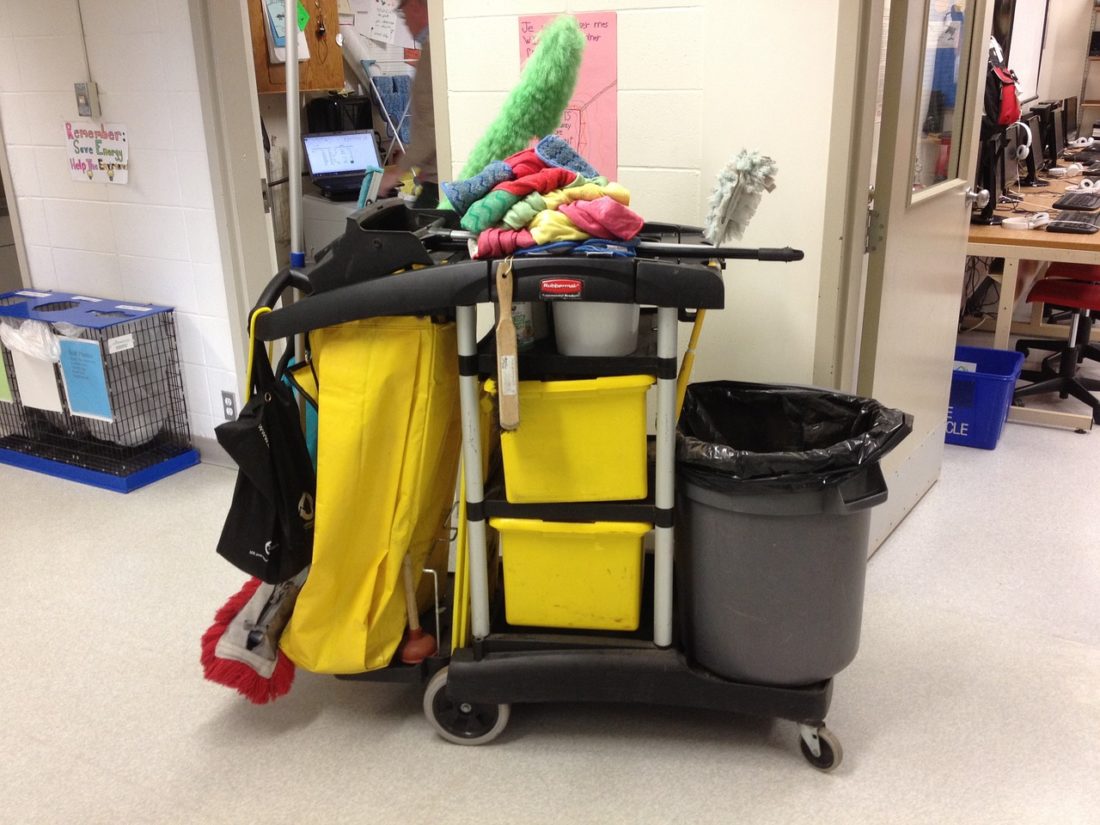
The trolley market is constantly evolving. Image, sustainability, flexibility, and cost are one of the chief factors to consider when choosing trolleys for your company’s cleaning sector. Of course, the model that you choose should have the proper configuration for your business needs. It should incorporate a wide range of cleaning tools, heavy buckets, and detergents in order for it to be viable as a portable cleaning system.
In other words, the ideal cleaning trolley should be maneuverable – sufficiently lightweight and easy to push while also being capable of navigating through narrow corridors and tight corners. But what type of cleaning trolley would you use in a hospital? An office? Or a hotel? Although all cleaning trolleys have a number of features in common (wheels, a handle, and storage space), there are different trolley requirements for various environments. Let’s find out which works best where – and why.
Table of Contents
Hospital Trolleys
All manufacturers agree that hospital trolleys need to prioritise safety and hygiene. The carts used in this environment should have good waste segregation facilities and should be able to store clean and dirty mops separately. Ergonomic and colour-coded cleaning materials are also important, along with drawers for storing detergents. It is particularly important to adapt the healthcare trolley to the environment it is used in.
In hospitals, typically there are large surfaces and long corridors that need to be cleaned, so it is crucial to maximise hygiene and minimise the risk of cross-contamination. The ideal hospital trolleys should be equipped with a lockable material box and their wheels should be designed to maintain direction and help the user keep control. A silent hospital trolley is a must – sick people should be able to rest undisturbed, which means the doors and lids must close silently and the trolley must move making as little noise as possible.
Furthermore, a hospital trolley should be big enough to accommodate sufficient flat mops, gloves and cloths so that new ones can be used in each room. Also, the storage and waste collection sections should be closed off for safety reasons. The ideal material for hospital trolleys is lightweight aluminium which can be disinfected at 90 degrees on a daily basis.
Office Trolleys
These should be compact and feature wheels that glide effortlessly across carpets (if any) with practically no noise. It is recommendable that their wheels are rubber-braked for safety reasons – the wheels should also be bigger, otherwise, too much force will be needed to push the trolley. Cleaning trolleys should be easy to maneuver in congested environments.
These carts are mainly designed for surface cleaning and waste collecting. To efficiently clean such environments, you would need a console for fresh waste bags, cloths and detergents. Furthermore, covered trolleys also leave a better impression as they are pretty much a central work station. The addition of waste and recycling compartments for collecting rubbish from individual desk bins is also a great idea that promotes sustainability.
Hotel Trolleys
These pieces of equipment should have plenty of room for towels and linen while also being sufficiently narrow for use in corridors. However, in hotel trolleys, there is an increasing emphasis on aesthetics due to the fact that they are becoming promotional tools that can improve a company’s image. No wonder why we are increasingly seeing logos, contact details, website addresses, slogans and images printed on trolleys using modern digital printing techniques.
Depending on whether the cleaning trolley will be used in the lobby, guest rooms, restaurant or conference rooms, the hotel’s needs may differ. Whatever the case may be, the trolley should be discreet so that cleaning can be carried out without any visual disturbance for the guests.
Ideally, hotel trolleys should be fully enclosed as pushing around a messy open trolley in front of guests could hurt the hotel’s image. They can also be equipped with shelves and drawers and have practical compartments and trays meant for amenity items. Simply said, the classic hotel trolley is a rolling storage facility.
Aesthetics Vs. Practicality
In today’s image-conscious society, the aesthetics of cleaning trolleys can play an important role in the impression that a company leaves on its customers. But do business owners really care about how their trolleys look like or are they more concerned about their practicality and price?
The truth of the matter is, although the main point of cleaning trolleys is to transport equipment and hygiene products to their point of use, in areas where daytime cleaning is carried out, these pieces of equipment are constantly displayed to the public. And we all know that a trolley that’s laden with mops, buckets, and other cleaning equipment, can be an unsightly mess. Plus, after several hours’ use, trolleys are very likely to house various other items such as soiled cleaning cloths, used mop heads, dirty water, and waste.
However, research shows that customers place far greater emphasis on a trolley that is ergonomically designed and easy to operate. The most sought-after features are convenient handling, high-quality materials, durability, and price. Modular systems that allow the trolley to be adapted as precisely as possible to the customer’s own requirements are trending more than ever.
A Compact Design
The key challenge when shopping for cleaning trolleys is to find models that are as compact as possible but still easy to use. For these items, clarity of design is imperative. When pushing the cleaning trolley, it is of utmost importance that the user has an unimpeded view ahead in order to reliably identify obstacles. It is also important that the user is able to easily and quickly accesses his/her equipment and materials. This is where drawers for accessories such as towels and toilet tissue come in helpful.
According to experts, there will be a growing need for more compact trolleys in the future. Chances are, we will also witness an increasing trend towards customised trolleys as well as a higher demand for sustainable solutions. Cleaning trolleys will continue to evolve in order to become more compact, convenient and efficient. The models of tomorrow will also be designed with the user’s posture in mind so that they can be used in total safety. The ‘green’ concept will become a must-have, with trolleys increasingly using recycled materials for their production and being developed for enhanced durability.







